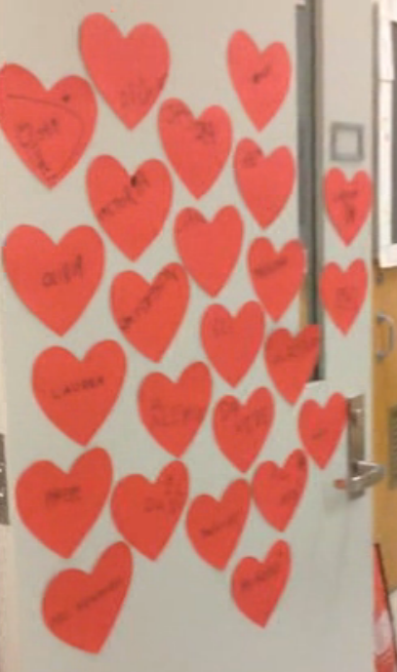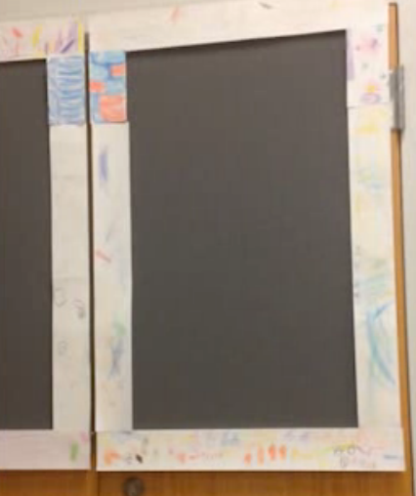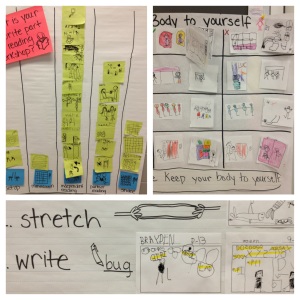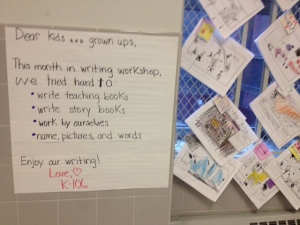as an intern in the literacy specialist program at TC, alyssa had the fortune of working in a third grade classroom at PS 59 for the semester. she remembers walking into the first day of her placement, scanning the room looking around at everything which seemed so ‘different’ after student teaching in non-project based schools in upstate NY. after scouring, she couldn’t help but ask herself “where’s the teacher’s desk? where does she keep all her… stuff?” too frightened to admit her dream of a perfectly organized teacher’s desk complete with heart shaped paper clips from papyrus was about to be crushed, she waited until later to bring the topic up in one of her grad classes- certain others would help her transform her thinking, “HOW DID YOU FORGET THE DESK IN THE STORAGE ROOM!?” into a more appropriate sentence. later than evening, EE, the fabulous literacy specialist coordinator at TC, who has an ever-so-gentle way of always saying the right thing at the right time, pushed back by asking, “what message does ‘the teacher’s desk’ send to our students? who does the room really belong to?”
a long way later, this question is a part of the foundation for some of our big work this year: give kids more ownership in the classroom. these are some of the things we kept in mind when starting off the year.
celebrate, don’t decorate.
when setting up our rooms to begin the year, we were both inspired and challenged to enter this year with what we called, ‘the 80/20 vision;’ a promise to ourselves that 80% of the classroom would be student generated. it’s easy to go overboard with the cutesy-ness, but it’s purposeful to go overboard with the kid-ness. we’ve been asking ourselves, “why is this here? what is the purpose?”

something about this entire bulletin used to show a pirate scene feels less-than-useful for kids (although pretty!)
we push ourselves to thread this question into our mindset when we have those, ‘take a step back and just look’ moments each week. here are some of the ways we’ve started off the year putting our students on the forefront, always celebrating and honoring their work, they best way they can do it.

our door is covered with hearts cut by alyssa, but the kids wrote their names inside on their own. a message to all: this is OUR room! i tried my best to write my name! oh and of course, what a special keepsake from the first day of kindergarten – our first attempts at writing our names.

bulletin borders made by the kids using sentence strip and crayons. gone are the days of spending money on store bought borders! this is much more meaningful, anyway.
…and if you feel like you just can’t let go of theme, then settle with the theme being a beautiful community. you can check out a more comprehensive look at alyssa’s room here.
this land is your our land, this land is my our land.
in peter johnston’s brilliant work, choice words, (if you haven’t read it, buy this now, with expedited shipping), johnston emphasizes the value and power of the words we use within our classrooms; he says the language of our classroom contributes to the discourse our students become a part of, so language influences the way children interact and perceive themselves and one another.
we think it’s fairly intimidating to acknowledge the responsibility that we have as teachers to arrange these interactions and perceptions in a manner that enables students to grow to believe in themselves as thinkers and learners. johnston explains this classroom discourse contributes to students’ understanding of who they are. so, the way children are positioned, and the way they position themselves does not come from “thin air” (johnston, 2001, p. 79). rather, it is “the ways we unwittingly use language to position them [the students] and provide them with the means to name and maim themselves” (johnston, 2001, p. 80).
we’re trying to push ourselves to think closely and carefully about the discourse we’re creating in regards to student ownership in our rooms. consider the following:
| instead of… |
try… |
| you cannot push other kids in my room |
you must keep your body to yourself in our room |
| can you please get me my markers? |
can you please bring our markers to me? |
| as you walk into the classroom… |
as you walk into our classroom… |
when we pay more careful attention to the language that we use, we know children will have the ability to make sense of this all in context, and to feel more empowered inside our classrooms.
be flexible & welcome advice.
for the first two months of kindergarten, we have found it helpful to plan each day with a very detailed plan, including all the materials we will need to prepare, some reminders of precisely what we’ll say during our teaching, duration of specific activities, etc. it’s easy to get trapped into our own plans because we’ve worked hard on them, because we’ve done it a certain way before, and let’s face it, we wrote them this way because we think this way will be the best way to do it. but when we do this, it’s so easy to miss out on opportunities for welcoming and celebrating plans our students might have.
alyssa had read many emergent storybooks (caps for sale, corduroy, three billy goats gruff) to her class to prepare for the upcoming unit of study in reading workshop, dubbing these, “heart books;” books that we love and have a special place in our heart because we know them so well. instead of a traditional share to close the workshop on the first day of the new unit (the launch), alyssa prepared some sheets with hearts on them for the kids to color in. these would go on the book bins which contained the “heart books” so kids would know which bin belonged to which table (i.e. all the red-ish hearts on one bin tells the red table that bin belongs to them.) the kids were overjoyed when they learned they would get to prepare the bins themselves and fill them up with the books. this was very different from what she has done in the past – premaking the labels and simply putting out the bins. as they colored and alyssa mentally pat herself on the back for being so student centered, one child asked, “how will the hearts stay on the bin? the tape isn’t that strong!” before alyssa could interject with her predetermined plan (laminate all the hearts, cut them out, use 3mm scotch foam tape to hold hearts down – it’s indestructibly sticky), the entire blue table had come up with the idea to glue the hearts onto a paper strip (sentence strip), and then tape the paper strip around the bin itself. BRILLIANT. (not to mention, major time saver!) if alyssa hadn’t heed her children’s advice, she might have spent columbus day laminating, cutting, and taping instead of blogging 🙂
scenarios like this one play out all the time, you just need to be on the look out. alyssa was going to hang the jobs chart in the same place she had last year, until a student shared, “it’s better over there [the closet door] because then everyone can see if from their table.” chart…moved.

interactive writing is supporting the creation of this tool together. we’re adding jobs as we go based on what’s needed, using student’s ideas as suggestions, instead of a pre-made chart from an outside vendor.
during writing workshop, another student called, “LOOK! a talking bubble! like creak! said the bed(!)” even though alyssa was planning to formally teach adding speech bubbles into your writing the following day, zachary’s excitement instigated the spur-of-the-moment, not-so-mid-workshop teaching point. needless to say, kindergarten writers are now on fire when it comes to adding ‘talking bubbles,’ just like zachary!
we know relinquishing control isn’t always easy. alyssa still has her own box of crayola crayons she uses for making charts, and no, she does not share them with her students (p.s. would you believe it if we told you they are the crayons she shared with her brother as a little kid over 25 years ago?) oh, and if you succumbed to creating a pinterest themed classroom, do not fear. we get the whole, “this feels scary…” thing, especially if you spent hours cutting out tiny zoo animals for your door, or shopping the fabric store to reupholster a bean bag chair. our advice is to start small: pick one way to make a change, and don’t forget to let us know how it goes!
stay tuned for next week for part II of this post, and see the way the kid-ness has infiltrated into deanna’s classroom, too!
we love hearing from you!! tweet: alyssa – @alyssalnewman deanna – @dee4soul us – @primaryperks mail: primaryperks@gmail.com






